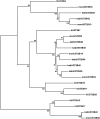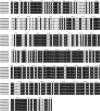Molecular cloning of the baboon UDP-glucuronosyltransferase 2B gene family and their activity in conjugating morphine
- PMID: 20071451
- PMCID: PMC2845934
- DOI: 10.1124/dmd.109.030635
Molecular cloning of the baboon UDP-glucuronosyltransferase 2B gene family and their activity in conjugating morphine
Abstract
Glucuronidation by UDP-glucuronyltransferase 2B enzymes (UGT2Bs) is a major pathway for the elimination of endobiotics and xenobiotics, including therapeutic drugs. Morphine, a probe drug for UGT2B7, is metabolized to morphine-3-beta-glucuronide (M3G) and morphine-6-beta-glucuronide (M6G) in humans. Morphine has been used in a series of experiments in the baboon to characterize developmental changes in fetal glucuronidation. This study identifies the baboon UGT2B family of enzymes, compares them with that of the human and the monkey (Macaca fascicularis), and measures the activity of the individual baboon UGT2Bs toward morphine. UGT2B cDNAs were cloned from the liver of adult and newborn baboons and expressed in human embryonic kidney 293 cells. The UGT activity toward morphine was assessed by the rate of formation of M3G and M6G by high-performance liquid chromatography. Eight baboon UGT2Bs were cloned and identified: UGT2B41 and UGT2B42, which are 90% homologous to human UGT2B4; UGT2B43, which is 93% homologous to human UGT2B15; and UGT2B39, UGT2B40, UGT2B44, UGT2B45, and UGT2B46, which are 89 to 91% homologous to human UGT2B7. Homology between baboon and monkey UGT2B ranged from 92.6 to 99.1%, with the primary protein structure of UGT2B43 being 99.1% identical to monkey UGT2B20, including a unique R96I substitution. Gene conversion interfered with the phylogenetic signal in the baboon UGT2B7-like and the monkey UGT2B4-like groups and led to concerted evolution of these enzymes. All of the baboon UGT2Bs metabolized morphine to both M3G and M6G. This study lays the foundation for investigating the regulation of UGT2B enzymes during fetal and neonatal development in the baboon.
Figures



Similar articles
-
Morphine glucuronidation and glucosidation represent complementary metabolic pathways that are both catalyzed by UDP-glucuronosyltransferase 2B7: kinetic, inhibition, and molecular modeling studies.J Pharmacol Exp Ther. 2014 Apr;349(1):126-37. doi: 10.1124/jpet.113.212258. Epub 2014 Jan 23. J Pharmacol Exp Ther. 2014. PMID: 24459244
-
N-glycosylation and residue 96 are involved in the functional properties of UDP-glucuronosyltransferase enzymes.Biochemistry. 2000 Sep 26;39(38):11540-52. doi: 10.1021/bi000779p. Biochemistry. 2000. PMID: 10995221
-
Cloning and characterization of a simian UDP-glucuronosyltransferase enzyme UGT2B20, a novel C19 steroid-conjugating protein.Biochem J. 1999 Feb 1;337 ( Pt 3)(Pt 3):567-74. Biochem J. 1999. PMID: 9895303 Free PMC article.
-
Morphine metabolites.Acta Anaesthesiol Scand. 1997 Jan;41(1 Pt 2):116-22. doi: 10.1111/j.1399-6576.1997.tb04625.x. Acta Anaesthesiol Scand. 1997. PMID: 9061094 Review.
-
Relationships among morphine metabolism, pain and side effects during long-term treatment: an update.J Pain Symptom Manage. 2003 Jan;25(1):74-91. doi: 10.1016/s0885-3924(02)00531-6. J Pain Symptom Manage. 2003. PMID: 12565191 Review.
Cited by
-
siRNA capsulated brain-targeted nanoparticles specifically knock down OATP2B1 in mice: a mechanism for acute morphine tolerance suppression.Sci Rep. 2016 Sep 15;6:33338. doi: 10.1038/srep33338. Sci Rep. 2016. PMID: 27629937 Free PMC article.
-
Predicting and Understanding the Human Microbiome's Impact on Pharmacology.Trends Pharmacol Sci. 2019 Jul;40(7):495-505. doi: 10.1016/j.tips.2019.04.014. Epub 2019 Jun 3. Trends Pharmacol Sci. 2019. PMID: 31171383 Free PMC article. Review.
-
Alterations of Cytochrome P450s and UDP-Glucuronosyltransferases in Brain Under Diseases and Their Clinical Significances.Front Pharmacol. 2021 Apr 21;12:650027. doi: 10.3389/fphar.2021.650027. eCollection 2021. Front Pharmacol. 2021. PMID: 33967789 Free PMC article. Review.
-
Pharmacokinetics of fluoxetine in pregnant baboons (Papio spp.).J Am Assoc Lab Anim Sci. 2014 Nov;53(6):708-16. J Am Assoc Lab Anim Sci. 2014. PMID: 25650979 Free PMC article.
-
Unraveling the effect of genomic structural changes in the rhesus macaque - implications for the adaptive role of inversions.BMC Genomics. 2014 Jun 26;15(1):530. doi: 10.1186/1471-2164-15-530. BMC Genomics. 2014. PMID: 24969235 Free PMC article.
References
-
- Barbier O, Bélanger A. (2003) The cynomolgus monkey (Macaca fascicularis) is the best animal model for the study of steroid glucuronidation. J Steroid Biochem Mol Biol 85:235–245 - PubMed
-
- Barbier O, Girard C, Breton R, Bélanger A, Hum DW. (2000b) N-Glycosylation and residue 96 are involved in the functional properties of UDP-glucuronosyltransferase enzymes. Biochemistry 39:11540–11552 - PubMed
-
- Barbier O, Lévesque E, Bélanger A, Hum DW. (1999b) UGT2B23, a novel uridine diphosphate-glucuronosyltransferase enzyme expressed in steroid target tissues that conjugates androgen and estrogen metabolites. Endocrinology 140:5538–5548 - PubMed
-
- Barbier O, Turgeon D, Girard C, Green MD, Tephly TR, Hum DW, Bélanger A. (2000a) 3′-azido-3′-deoxythimidine (AZT) is glucuronidated by human UDP-glucuronosyltransferase 2B7 (UGT2B7). Drug Metab Dispos 28:497–502 - PubMed
Publication types
MeSH terms
Substances
Grants and funding
LinkOut - more resources
Full Text Sources

